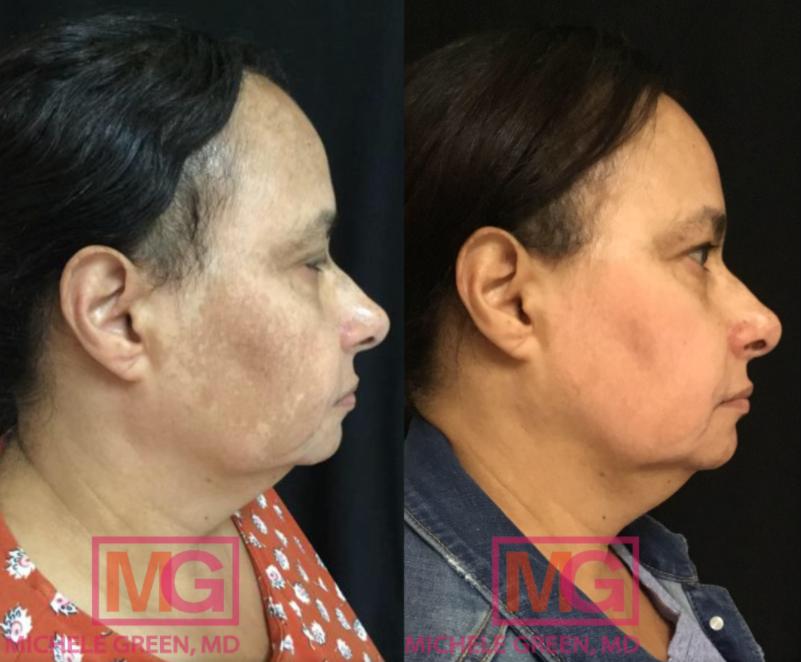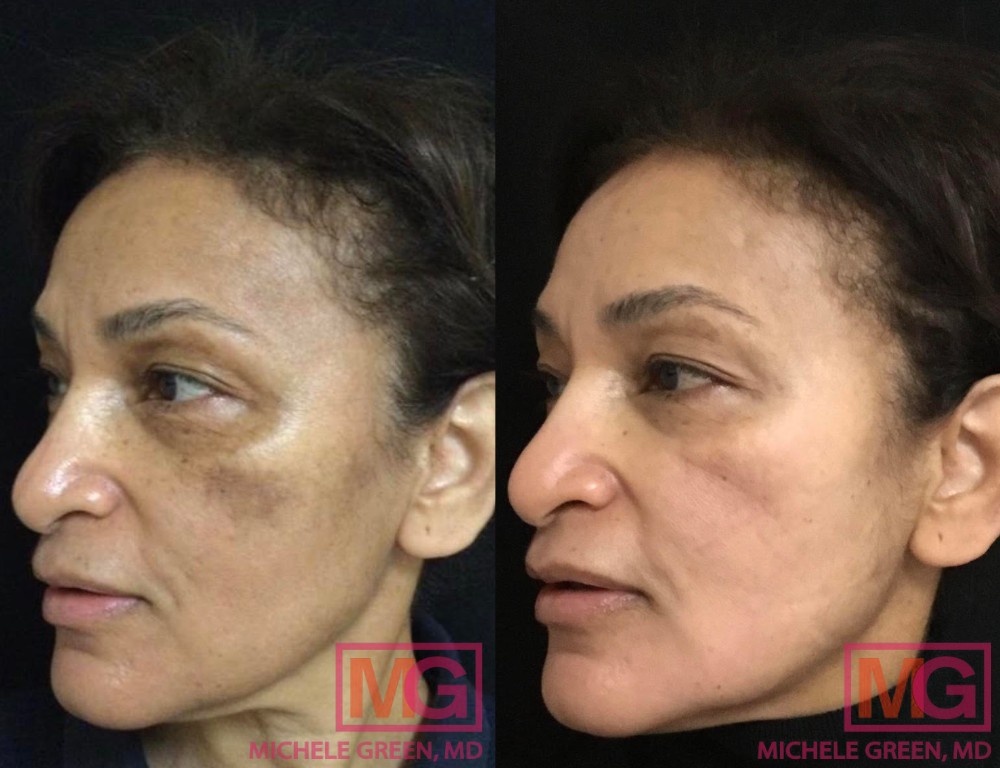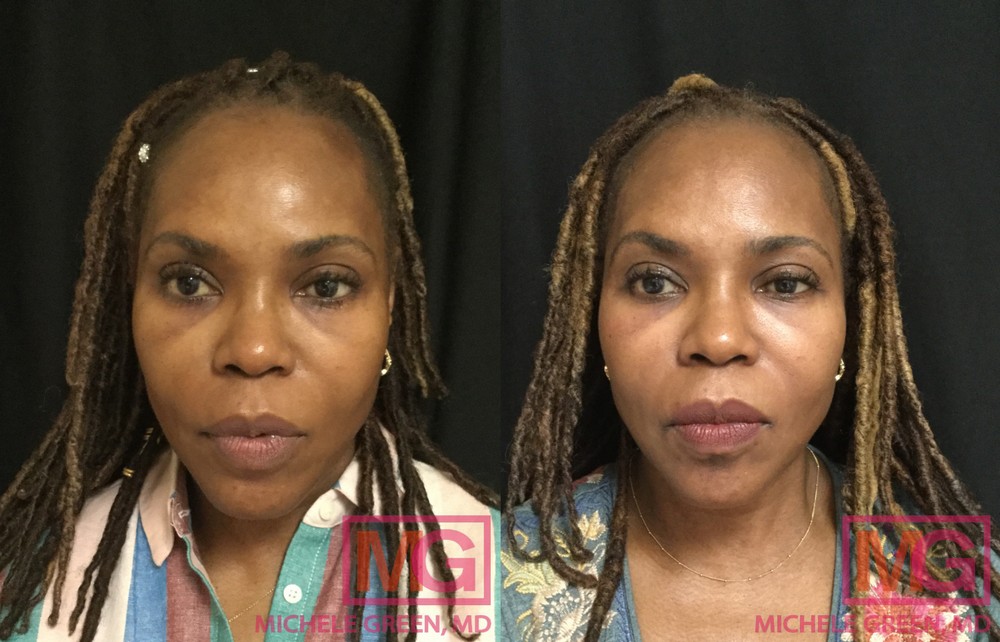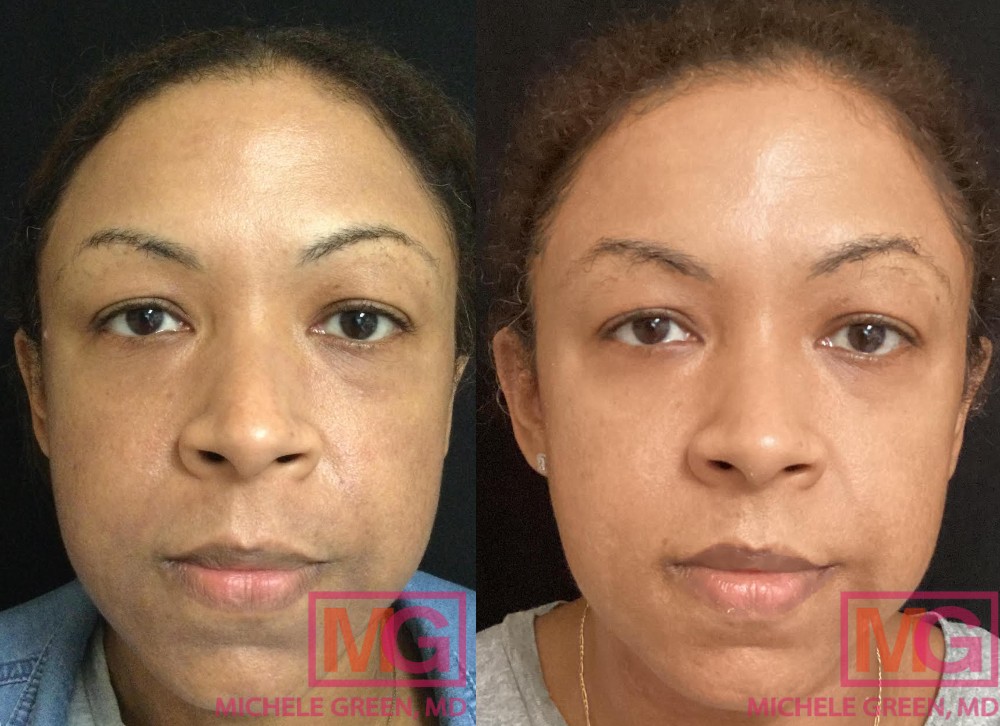The Best Creams for Melasma
Melasma is a skin condition characterized by uneven brown or gray patches appearing on the skin’s surface. While the exact cause of the condition is not yet known, studies have shown that sun damage, unprotected exposure to UVA and UVB rays of light, and hormonal changes considerably worsen the discoloration associated with melasma. Melasma tends to affect patients with darker skin tones at a higher rate than patients with lighter skin tones due to the higher concentrations of melanin and the activity of melanocytes in darker skin. Melasma cannot be completely cured, leading patients to wonder if there are methods that are effective in managing the condition and depigmenting the affected areas. Luckily, expert board-certified dermatologist Dr. Michele Green has many treatment options available at her New York City dermatology office.
Topical solutions are some of the most effective treatment options for reducing the appearance of melasma. With many types of topical creams to choose from, Dr. Green often prescribes a combination approach to melasma treatment. Most often, Dr. Green will turn to topical creams that contain ingredients such as tranexamic acid, azelaic acid, kojic acid, niacinamide, and cysteamine to inhibit excess melanin production and reduce the appearance of melasma. Other topical solutions, such as retinoids like retinol and tretinoin, help to promote skin cell turnover, which brightens the skin and improves skin tone and texture. The best first step for the treatment of melasma is to schedule an appointment with Dr. Green to determine which topical solution is best for you.
Experienced board-certified dermatologist Dr. Michele Green has been masterfully treating patients in her Upper East Side New York City dermatology office for more than 25 years. With her proprietary range of skincare products, MGSKINLABs, Dr. Green is an expert in providing patients with individualized treatment plans tailored to their skin type and aesthetic goals. Whether you are concerned about sensitive skin, hyperpigmentation, dark spots, melasma, or signs of the natural aging process, Dr. Green has plenty of treatment options available. In addition to generating individualized skincare plans, Dr. Green has a range of in-office treatments that can help with melasma management and treatment, including chemical peels, mesopeels, microneedling, microdermabrasion, laser treatments, and Cosmelan peels. Well-known for high patient satisfaction, Dr. Green has been voted one of the best dermatologists in New York City by such publications as Castle Connolly, Super Doctors, and New York Magazine.
What is melasma?
Melasma is a skin condition characterized by areas of pigmentation due to the overproduction of melanin. These blotchy gray or brown patches of discoloration appear most commonly on areas of the face, such as the upper lip, cheeks, bridge of the nose, and forehead. Three main types of melasma exist: epidermal melasma, which is when pigmentation appears on the outer layer of the skin; dermal melasma, which is when the pigmentation is located in the middle layer of the skin (known as the dermal layer); and mixed melasma, which is when the pigmentation is present both in the middle and outer layers of skin.
Melasma occurs when the pigment melanin is overproduced in the melanocytes, which are responsible for producing melanin. When melanin is overproduced, it causes uneven pigmentation across the skin’s surface, resulting in uneven dark patches. The exact cause of the skin condition is not yet known. However, several major risk factors increase the likelihood of developing melasma:
Sun exposure is a significant factor in the development and worsening of melasma. The sun emits several forms of light that can contribute to the condition, including UVA and UVB rays and visible light, such as blue light. Without UVA and UVB protection, these rays of light trigger the overproduction of melanin in the skin, exacerbating melasma and darkening the patches of pigmentation. In fact, sun exposure is the most common trigger for breakouts of melasma, becoming especially prevalent in summer months when patients spend more time in the sun. Understanding the role of sun exposure in melasma can empower you to take the necessary steps to protect your skin and prevent flare-ups.
Skin Tone: Patients with darker skin tones — III-VI on the Fitzpatrick scale — are more likely to experience melasma, as there are more active melanocytes present in the skin. Many patients of color do not experience sunburn and, for that reason, do not wear sunscreen. However, sunscreen is very important for skin of color to prevent melasma breakouts.
Hormonal changes: High levels of the hormone estrogen can also contribute to melasma flare-ups. Melasma is particularly common in pregnant women and people—so much so that the skin condition is often referred to as the “Mask of Pregnancy.” However, it is much less common in patients assigned male at birth, as, according to the American Academy of Dermatology, only 10% of melasma patients are male. Birth control pills containing estrogen and progesterone may also contribute to melasma flare-ups.

What is the dermatologist-recommended topical melasma treatment?
Melasma cannot be cured, but there are many treatment options to help manage melasma flare-ups and other forms of hyperpigmentation, such as post-inflammatory hyperpigmentation (PIH). The best way to manage the skin condition is to prevent flare-ups by reducing exposure to known triggers, such as sun exposure. To do so, Dr. Green recommends the use of a broad-spectrum SPF 50 sunscreen applied every morning and reapplied throughout the day, especially when spending significant time outside. Some medications can also cause flare-ups to occur, so Dr. Green recommends speaking with your primary care provider to try other medications if that is the case.
When experiencing a melasma flare-up, Dr. Green recommends a combination of skin care products and in-office treatments to reduce the symptoms:
Topical Skin-Lightening Products, such as:
- Hydroquinone cream: a topical cream that can be prescribed to help lighten areas of hyperpigmentation
- Tretinoin (Retin-A): a topical retinoid for skin lightening
- Vitamin-C serum: a powerful antioxidant to address areas of pigmentation
- Glycolic Acid: a chemical exfoliant that helps to boost skin cell turnover
- Corticosteroid cream: a topical treatment with anti-inflammatory properties
With skincare products, Dr. Green may turn to the triple combination approach, which pairs hydroquinone cream with tretinoin (or another vitamin A-based treatment) and corticosteroids.
Chemical Peels can be performed in-office to improve skin tone and texture without the need for significant downtime or the risk of serious side effects. They work by applying a topical chemical solution that reacts with the dead skin cells and debris on the skin’s surface, causing them to slough off and boosting skin cell turnover for clearer, brighter, lighter skin. Dr. Green is an expert in many different types of chemical peels, which have a range of active ingredients to address various skin concerns but will often turn to the TCA peel for melasma.
Cosmelan Peel: A professional-grade mask applied in-office, the Cosmelan Peel is often Dr. Green’s go-to for melasma treatment. Based on the severity of the pigmentation, skin tone, and skin type, Dr. Green will determine the amount of time needed for the peel to stay on the patient’s face. Patients can then wipe away the mask at home using a gentle cleanser. The resulting skin peeling will help provide patients with smoother, clearer, brighter skin and reduce the appearance of melasma.

How do skincare products work for dark spots and hyperpigmentation?
Skincare products, such as creams, serums, and sun protection, are highly effective treatments for skin pigmentation conditions like melasma, post-inflammatory hyperpigmentation, rosacea, and sun spots. Skincare products can vary in concentrations to target various aspects of the process of generating excess pigment and aiding in depigmenting the treatment area. Some skincare products, such as glycolic acid, retinoids, and vitamin C, act as pigment correctors by increasing skin cell turnover for more even skin tone and brighter skin. Other skincare products contain ingredients such as tranexamic acid, kojic acid, niacinamide, azelaic acid, and cysteamine, which all work to inhibit the melanin production process to reduce increased skin pigmentation. For the best treatment results, Dr. Green may use a combination approach to melasma treatment.
What is the best melasma cream?
Patients often ask, “What is the best cream to treat melasma?” The answer depends on several factors, including the severity of the melasma, skin tone, and skin type. The first step for determining the best melasma cream for you is to schedule a consultation appointment with Dr. Green. Your appointment will begin with an examination of the treatment area, and Dr. Green may perform tests to determine if the excess pigment is, in fact, melasma. After that, Dr. Green will generate a treatment plan consisting of either over-the-counter creams or prescription topical medications for the treatment of melasma. Typically, the best topical treatments contain ingredients such as tranexamic acid, azelaic acid, kojic acid, niacinamide, cysteamine, hydroquinone, vitamin A, or vitamin C.
How to treat melasma with azelaic acid
Azelaic acid is a prescription topical medication used to treat melasma flare-ups and prevent additional hyperpigmentation. The medication affects tyrosinase, an enzyme involved in the production of melanin. As a tyrosinase inhibitor, azelaic acid interferes with melanin production, reducing the appearance of pigmentation on the skin’s surface. In addition to inhibiting the functioning of tyrosinase, azelaic acid has anti-inflammatory properties.

Does hydroquinone skin brightening work for melasma?
Hydroquinone is a common ingredient in skin-lightening creams that comes in a range of strengths and concentrations. While hydroquinone is not FDA-approved for over-the-counter products, it can be found in prescription skin-lightening products. Dr. Green may prescribe hydroquinone in combination with other topical treatments, such as retinoids or corticosteroids. As an ingredient, hydroquinone can cause skin irritation and post-inflammatory hyperpigmentation when used for a prolonged period. As such, Dr. Green will not prescribe hydroquinone for extended use.
Tretinoin vs. Retinol for treating melasma
Tretinoin and retinol are both vitamin A-based products that can be used for skin lightening and inducing skin cell turnover. When applied to the skin’s surface, tretinoin and retinol cause dead, pigmented skin cells to slough off, creating the opportunity for healthy, clear, bright new skin cells to form. Tretinoin and retinol differ in that tretinoin is the prescription-strength version of retinol. Both products can irritate the skin’s surface, so patients should be advised to apply as directed. Generally, Dr. Green will recommend starting with a low concentration applied once a day and increasing as needed.
Is topical Vitamin C good for melasma?
Vitamin C is a powerful antioxidant found in skincare products. It reduces the appearance of pigmentation and improves skin tone and texture, making it an excellent option for melasma treatment. One of the most popular products available in Dr. Green’s proprietary line of skin care products—MGSKINLABs—is her Vita-C serum. Safe and effective for all skin types, Vita-C serum can be used to reduce the appearance of melasma, enhance protection against ultraviolet rays, and reduce inflammation from conditions such as rosacea.
What sunscreen SPF should be used for patients with melasma?
Wearing sunscreen is perhaps the most important step in managing melasma, as sunscreen can help prevent melasma flare-ups and reduce the severity of the condition. Dr. Green highly recommends that patients add broad-spectrum sunscreen application to their daily skincare routine. In the morning, patients should wash their face with a gentle cleanser, apply a light, hydrating moisturizer, and then a broad-spectrum SPF 50 sunscreen. Even when you are inside, UVA rays can still filter through some windows and cause melasma to flare up, which is why it is imperative to wear sunscreen every day. When patients do spend significant time outside, Dr. Green suggests reapplying sunscreen every two hours to ensure full UVA and UVB protection.
There are two overarching types of sunscreen available: chemical sunscreen, which contains active ingredients such as oxybenzone, avobenzone, and cinnamates to protect against UVA and UVA rays, and physical sunscreen, which contains active ingredients such as zinc oxide, titanium dioxide, and iron oxide to create a physical blocker of UVA and UVB rays. Dr. Green recommends the use of both a chemical and a physical sunscreen for the best sun protection results.
What is the best moisturizer for patients with melasma?
Applying a moisturizer is an important part of any daily skincare routine. Dr. Green often recommends that patients with melasma turn to a moisturizer with SPF or a tinted moisturizer to help protect from the sun’s UV rays. SPF moisturizer that gives SPF 30 protection can be a useful base layer before applying other types of sunscreen.

What cream is good for melasma?
Patients often ask, “What creams are good for melasma?” The answer is that there are many highly effective treatment options available both over-the-counter and by prescription. When looking for over-the-counter products, it is best to find creams that contain ingredients such as azelaic acid, kojic acid, niacinamide, cysteamine, and tranexamic acid. These ingredients work in different ways to inhibit the production of melanin in the body, reducing the appearance of melasma. Topical retinoids are also effective at controlling the symptoms of melasma and brightening the skin by promoting skin cell turnover. Some patients may find that the best solution is hydroquinone-based creams, which Dr. Green may prescribe for a short period.
How to use melasma creams
Many types of melasma creams are available to treat and manage melasma. The method of application and number of times a day (or week) to apply the melasma treatment depends on the concentration and strength of the product. Some prescription topical creams are powerful exfoliants, meaning that they can irritate the skin when over-used, which can make melasma worse. That is why it is essential to apply melasma creams as directed by a dermatologist, such as Dr. Michele Green.
Where to buy melasma cream
Some melasma creams are available over the counter, while others require a prescription. During your initial consultation, Dr. Green will examine the treatment area and discuss your medical history to determine the topical treatments that will work best for you. Over-the-counter products can be purchased at most local pharmacies. Should a patient require a prescription topical solution, Dr. Green will write the prescription to be filled at their local pharmacy.
How to get rid of melasma with creams
While melasma cannot be fully cured, the symptoms can be managed with topical creams, solutions, and serums. The best course of action is to meet with a board-certified dermatologist like Dr. Michele Green to generate a treatment plan that will meet your needs. The best melasma cream for you will depend on the type of melasma, the severity of the case, and your skin type. It is important to apply topical melasma creams as directed to avoid any irritation to the skin, which could further exacerbate the skin condition.
Does estrogen cream cause melasma?
Hormonal changes can trigger the worsening of melasma, specifically fluctuations in the female hormones estrogen and progesterone, as these hormones lead to an increase in the concentration of melanocytes. Pregnant people often experience flare-ups of melasma, which is why the condition is often known as the “mask of pregnancy.” Oral contraceptives—also known as birth control pills—can also contribute to a worsening of melasma. Estrogen cream can have the same effect.
What products make melasma worse?
Certain skincare products and medications can trigger flare-ups in melasma and worsen the condition. Certain medications, including some antibiotics, non-steroidal anti-inflammatory drugs, and more, are known as phototoxic drugs, meaning they make the skin more sensitive to sunlight. Sunlight is a common trigger for melasma, meaning these medications can increase the risk of developing melasma. Skincare products that are harsh or irritating, including scented soaps and chemical exfoliants, can also make melasma worse.
Do hyperpigmentation creams work?
Melasma is a skin condition in which areas of pigmentation appear, most often on the face, due to increased melanin production triggered by hormonal changes, sun exposure, or other irritants. Topical creams containing ingredients like hydroquinone, azelaic acid, kojic acid, niacinamide, cysteamine, tranexamic acid, vitamin A, and vitamin C are highly effective treatment options for hyperpigmentation. Melasma is a notoriously difficult condition to treat, but topical solutions with these ingredients can help to manage the condition, reduce the appearance of pigmentation, and improve overall skin tone.
How do I get started with melasma treatment today?
Melasma is a skin condition characterized by uneven brown patches of skin most frequently found on the face, such as above the lip, on the forehead, on the nose, and on the cheeks. With melasma so commonly found on the face, a highly visible area of the body, many patients wonder how to reduce the symptoms of the skin condition and prevent flare-ups from occurring. Luckily, many topical creams and solutions can be applied to the treatment area to reduce the appearance of pigmentation, improve skin tone, and create a more even skin texture. However, with a wide variety of treatment options, it can be difficult to know which will be most effective for you. That is why the best first step for treatment is to schedule a consultation with expert dermatologist Dr. Michele Green, who will examine the treatment area and generate a treatment plan that best meets your needs.
Dr. Michele Green is an internationally renowned board-certified dermatologist with over two and a half decades of experience providing her patients with the best non-invasive treatment options. Dr. Green takes a holistic approach and embraces a less-is-more philosophy, creating customized skincare routines and treatment plans that cater to the unique concerns and aesthetic goals of her patients. She is consistently identified as one of New York’s best dermatologists by Castle Connolly, New York Magazine, and Super Doctors for her dedication to her patients and expertise. Please call us at 212-535-3088 or email our New York City-based office today to schedule a consultation with Dr. Michele Green and determine the skincare routine for melasma management that is right for you.
 212-535-3088
212-535-3088